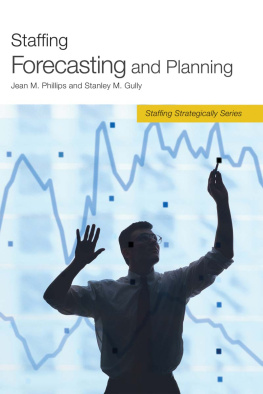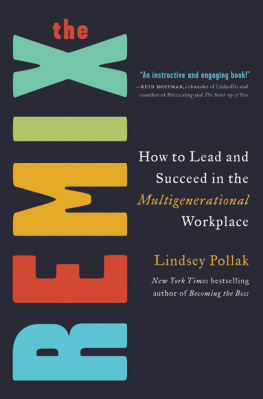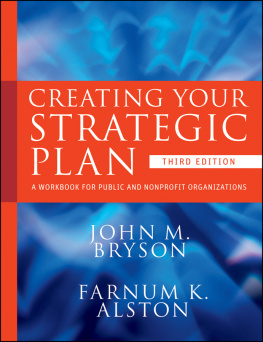POSITIONED
Strategic Workforce Planning
That Gets the Right Person in the Right Job
Dan L. Ward
and Rob Tripp with Bill Maki

Bulk discounts available. For details visit:
www.amacombooks.org/go/specialsales
Or contact special sales:
Phone: 800-250-5308
Email:
View all the AMACOM titles at: www.amacombooks.org
American Management Association: www.amanet.org
This publication is designed to provide accurate and authoritative information in regard to the subject matter covered. It is sold with the understanding that the publisher is not engaged in rendering legal, accounting, or other professional service. If legal advice or other expert assistance is required, the services of a competent professional person should be sought.
Library of Congress Cataloging-in-Publication Data
Ward, Dan L.
Positioned : strategic workforce planning that gets the right person in the right job / Dan L. Ward and Rob Tripp, with Bill Maki.
p. cm.
Includes index.
ISBN-13: 978-0-8144-3247-1
ISBN-10: 0-8144-3247-6
1. Manpower planning. 2. Personnel management. 3. Strategic planning. I. Tripp, Rob. II. Maki, Bill. III. Title.
HF5549.5.M3W37 2013
658.301dc23
2012040290
2013 Rob Tripp and Dan L. Ward
All rights reserved.
Printed in the United States of America.
This publication may not be reproduced, stored in a retrieval system, or transmitted in whole or in part, in any form or by any means, electronic, mechanical, photocopying, recording, or otherwise, without the prior written permission of AMACOM, a division of American Management Association, 1601 Broadway, New York, NY 10019
The scanning, uploading, or distribution of this book via the Internet or any other means without the express permission of the publisher is illegal and punishable by law. Please purchase only authorized electronic editions of this work and do not participate in or encourage piracy of copyrighted materials, electronically or otherwise. Your support of the authors rights is appreciated.
About AMA
American Management Association ( www.amanet.org ) is a world leader in talent development, advancing the skills of individuals to drive business success. Our mission is to support the goals of individuals and organizations through a complete range of products and services, including classroom and virtual seminars, webcasts, webinars, podcasts, conferences, corporate and government solutions, business books, and research. AMAs approach to improving performance combines experiential learninglearning through doingwith opportunities for ongoing professional growth at every step of ones career journey.
Printing number
10 9 8 7 6 5 4 3 2 1
Contents
Rob Tripp and Dan L. Ward with Bill Maki
Dan L. Ward
James W. Walker
Dan L. Ward
Alex G. Manganaris
Rob Tripp
Robert D. Motion
Dianna Peterson and Tina Krieger
Mary Boudreaux Carroll
David Howerton
Jeff Buchmiller
Naomi Stanford
James David Eyring and Alison Romney Eyring
Marta Brito Perez
Rachel Bangasser
Laura Chalkley
Marco Better, Fred Glover, Dave Sutherland, and Manuel Laguna
Peter Howes
Dan Hilbert
Rob Tripp
Jeremy Shapiro and Thomas H. Davenport
Leo Sadovy and Christian Haxholdt
Amit B. Mohindra and J. Allan Brown
Dan L. Ward
Jac Fitz-enz
John Boudreau and Ian Ziskin
Steve Arneson
Dave Ulrich
Dan L. Ward
Preface
Rob Tripp and Dan L. Ward with Bill Maki
THIS BOOK IS ABOUT the variety of tools, techniques, and processes collectively known as Strategic Workforce Planning (SWP.) It is about getting people resources when and where you need them and doing it efficiently and effectively. SWP is a fundamental requirement for survival as an organization. When done well, it provides competitive advantage. When done poorly, it results in a breakdown of the alignment between objectives and execution.
The authors of the individual pieces you will find in this book were selected because they are among the best in the world as shown by their actual performance or their record of effective research and analysis on workforce-related topics. The book is divided into four primary sections. The first provides a historical perspective on the evolution of the field, the second provides firsthand accounts from some of the people currently practicing in the field, the third drills down into analytics that have emerged as the field has matured, and the fourth takes a look at future directions for this type of work.
In the 1970s, the U.S. Department of Labor provided Manpower Institution Grants to a number of universities to promote study of improved workforce analysis. Dan Ward was one of the products of an applied economics graduate program developed under this funding, with a strong focus on econometric modeling and applying cost measurement techniques to social sciences. We measured everything that we could measure and counted everything we could count and created forecasts, projections, and simulations, he says.
Rob Tripp came to this field from a different direction. With a Ph.D. in statistics, he was hired right out of graduate school into the U.S. auto industry, where he built complex models to simulate the impact of business actions on the hourly workforce, supporting strategic business planning and union contract negotiations.
Many traditional human resources colleagues were envious of the successes of these people, who were bringing a quantitative approach to workforce issues. These new workforce planners always seemed to be able to get funding for their proposals, while most traditional HR projects were rejected. The reason was simple. These trained workforce planners came to the table armed with hard data and spoke the language of business: numbers. It was a heady period for the early workforce planning professionals. We made forecasts of turnover and projected recruiting and staffing numbersbuilding beautiful models and scenarios that drove action plans.
Over the years, we began to realize that while these tools were critical, they were not sufficient in and of themselves. We regularly hear truisms such as What gets measured gets done. What gets rewarded gets repeated. We realized that performance metrics can drive behavior but not always the desired behavior. Ineffective or misguided planning can take an organization down the wrong path. There can be serious unintended and unrecognized consequences of a well-executed but poorly conceived plan.
In his presentations, John Boudreau uses a slide that says Not everything that can be counted counts and not everything that counts can be counted. Our solutions need to blend comprehensive data with social, behavioral, and cultural insights to be truly effective in the long run. Truly effective Strategic Workforce Planning is more than an exercise to run the numbers: It is ultimately a disciplined conversation about talent, especially strategically critical talent, and it puts the metrics, projections, forecasts, and scenarios in a total organizational context and ensures that the discrete parts are aligned against a truly strategic perspective.
DEDICATION








